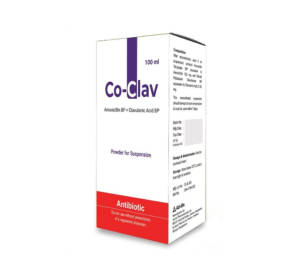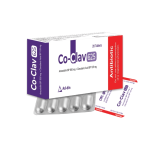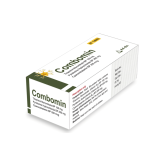Co-Clav Powder for Suspension

Amoxicillin + Clavulanic Acid
Indications
Co-amoxiclav is indicated for short-term treatment of bacterial infections at the following sites:
- Upper respiratory tract infections (including ENT) e.g.tonsillitis,sinusitis,otitis media.
- Lower respiratory tract infections e.g.acute and chronic bronchitis, lobar and bronchopneumonia.
- Genito-urinary tract infections e.g.cystitis,urethritis,pyelonephritis.
- Skin and soft tissue infections.
- Bone and joint infections e.g.osteomyelitis.
- Other infections e.g.septic abortion,puerperal sepsis,intra-abdominal sepsis etc.
Composition
- 375 mg tablet: Each film coated tablet contains Amoxicillin 250 mg as Amoxicillin Trihydrate BP and Clavulanic Acid 125 mg as Diluted Potassium Clavulanate BP.
- 625 mg tablet: Each film coated tablet contains Amoxicillin 500 mg as Amoxicillin Trihydrate BP and Clavulanic Acid 125 mg as Diluted Potassium Clavulanate BP.
- 1 gm tablet: Each film coated tablet contains Amoxicillin 875 mg as Amoxicillin Trihydrate BP and Clavulanic Acid 125 mg Diluted Potassium Clavulanate BP.
- Powder for Suspension: Each 5 ml reconstituted suspension contains Amoxicillin 125 mg as Amoxicillin Trihydrate BP and Clavulanic Acid 31.25 mg as Diluted Potassium Clavulanate BP.
- Powder for Suspension (Forte): Each 5 ml reconstituted suspension contains Amoxicillin 400 mg as Amoxicillin Trihydrate BP and Clavulanic Acid 57.5 mg as Diluted Potassium Clavulanate BP.
- 1.2 gm Injection: Each vial contains sterile mixture of Amoxicillin Sodium BP (equivalent to Amoxicillin 1 gm) and Clavulanate Potassium USP (equivalent to Clavulanic Acid 200 mg).
- 0.6 gm injection: Each vial contains sterile mixture of Amoxicillin Sodium BP (equivalent to Amoxicillin 500) and Clavulanate Potassium USP (equivalent to Clavulanic Acid 100 mg).
Pharmacology
Pharmacodynamic properties: Co-amoxiclav is an antibacterial combination consisting of the antibiotic Amoxicillin and the (3-lactamase inhibitor Clavulanic Acid. Amoxicillin has a broad spectrum of bactericidal activity against many Gram-positive & Gram-negative microorganisms but it is susceptible to degradation by (3-lactamases and therefore the spectrum of activity does not include microorganisms, which produce these enzymes. Clavulanic acid possesses the ability to inactivate a wide range of beta-lactamase enzymes commonly found in microorganisms resistant to penicillins and cephalosporins. Thus Clavulanic acid in this preparation protects Amoxicillin from degradation by (3-lactamase enzymes and effectively extends the antibiotic spectrum to embrace a wide range of microorganisms.
Pharmacokinetic properties: The pharmacokinetics of the two components of Co-amoxiclav is closely matched. Peak serum levels of both occur about one hour after oral administration. Absorption of Co-amoxiclav is optimized at the start of a meal. Both clavulanate and Amoxicillin have low levels of serum binding; about 70% remains free in the serum. Doubling the dosage of Co-amoxiclav approximately doubles the serum levels achieved.
Dosage
Adults and children over 12 years:
Tablet:
- The usual adult dose is one 625 mg Tablet every 12 hours or one 375 mg Tablet every 8 hours.
- For more severe infections and infections of the respiratory tract, the dose should be one 1 gm Tablet every 12 hours or one 625 mg Tablet every 8 hours.
Suspension:
- Children 6-12 years: 2 teaspoonful every 8 hours.
- Children 1-6years: 1 teaspoonful every 8 hours.
- Children below 1 year: 25 mg/kg/day in divided doses every 8 hours, for example a 7.5 kg child would require 2 ml suspension t.i.d, Treatment should not be extended beyond 14 days without review.
Forte suspension:
- The usual recommended daily dosage: 25/3.6 mg/kg/day in mild to moderate infections (upper respiratory tract infections e.g. recurrent tonsilitis, lower respiratory infections, and skin and soft tissue infections)।
- For serious infections: 45/6.4 mg/kg/day for the treatment of more serious infections (upper respiratory tract infections, e.g. otitis media and sinusitis, lower respiratory infections e.g. bronchopneumonia, and urinary tract infections).
Children of 2 to 12 years:
Mild to moderate infections:
- 25/3.6 mg/kg/day (Suspension)
- 2-6 years (13-21 kg) 2.5 ml suspension b.i.d
- 7-12years (22-40kg) 5 ml suspension b.i.d
Serious infections:
- 45/6.4 mg/kg/day (Forte Suspension)
- 2-6 years (13-21 kg) 5 ml suspension b.i.d
- 7-12 years (22-40 kg) 10 ml suspension b.i.d
IV Injection
Adults-
- Usually, 1.2 gm every 8 hours
- Increased in more serious infections to 1.2 gm every 6 hours
- For surgical prophylaxis: The usual dose is 1.2 gm at induction, for high risk procedures (eg. colorectal surgery) up to 2-3 gm may be given every 8 hours.
Children-
- 0 to 3 months: 30 mg/kg every 8 hours. (every 12 hours in the perinatal period and in premature infants.
- 3 months to 12 years: Usually 30 mg/kg every 8 hours increased in more serious infection to 30 mg/kg every 6 hours.
Administration
Oral dosage form: This may be taken without regard to meals; however, absorption of clavulanate potassium is enhanced when Amoxicillin and Clavulanic acid are administered at the start of a meal. To minimize the potential for gastrointestinal intolerance, Amoxicillin and Clavulanic acid should be taken at the start of the meal.
IV injection is not suitable for intramuscular or subcutaneous administration. The reconstituted vial can be administered intravenously by injection (over 2 minutes) or slow intravenous infusion (30 minutes). The contents of the content of the vial must be used within 20 minutes and thereafter any unused material should be discarded.
Interaction
Prolongation of bleeding time and prothrombin time have been reported in some patients receiving Co-amoxiclav. In common with other broad-spectrum antibiotics, Co-amoxiclav may reduce the efficacy of oral contraceptives and patients should be warned accordingly. Concomitant use of allopurinol during treatment with amoxicillin can increase the likelihood of allergic skin reactions. There are no data on the concomitant use of Co-amoxiclav and allopurinol.
Contraindications
History of Penicillin hypersensitivity. Attention should be paid to possible cross-sensitivity with other beta-lactam antibiotics e.g. cephalosporins. Also contraindicated for patients with a previous history of Co-amoxiclav or Penicillin-associated cholestatic jaundice.
Side Effects
Side effects, as with Amoxicillin, are uncommon and mainly of a mild and transitory nature. Diarrhoea, pseudomembranous colitis, indigestion, nausea, vomiting and candidiasis have been reported, if gastrointestinal side effects occur with oral therapy, that may be reduced by taking Co-amoxiclav at the start of meals. Hepatitis and cholestatic jaundice have been reported rarely but are usually reversible. Urticarial and erythematous rashes sometimes occur. Rarely erythema multiforme, Stevens-Johnson Syndrome and exfoliative dermatitis have been reported. In common with other beta-lactam antibiotics, angioedema and anaphylaxis have been reported.
Pregnancy & Lactation
Animal studies with orally and parenterally administered Co-amoxiclav have shown no teratogenic effect. The drug has been used orally in human pregnancy in a limited number of cases with no untoward effect; however, the use of Co-amoxiclav in pregnancy is not recommended unless considered essential by the physician. During lactation, trace quantities of Amoxicillin can be detected in breast milk.
Precautions & Warnings
Co-amoxiclav should be used with care in patients on anticoagulation therapy or with severe hepatic dysfunction. In patients with moderate or severe renal impairment, dosage should be adjusted. During the administration of a high dose of Co-amoxiclav adequate fluid intake and urinary output should be maintained to minimize the possibility of crystalluria.
Use in Special Populations
The dose should be adjusted in case of patients with renal impairment
Adult:
- Mild impairment (Creatinine clearance> 30ml/minute): No changein dosage.
- Moderate impairment (Creatinine clearance 10-30 ml/minute): One 375 Tablet or one 625 Tablet 12 hourly or 1.2 gm IV followed by 0.6 gm IV 12 hourly.
- Severe impairment (Creatinine clearance <10 ml/minute): Not more than one 375 mg tablet 12 hourly or 1.2 gm IV followed by 0.6 gm IV 24 hourly. Dialysis decreases serum concentrations of Co-Clav and an additional 0.6 gm IV dose may need to be given during dialysis and at the end of dialysis.
Children:
- A similar reduction in dosage should be made for children.
- Administration hepatic impairment: Dose with caution; monitor hepatic function at regular intervals.
Overdose Effects
Problems of overdose with Co-amoxiclav are unlikely to occur, if encountered gastrointestinal symptoms and disturbance of the fluid and electrolyte balances may be evident. Co-amoxiclav may be removed from the circulation by haemodialysis.
Therapeutic Class
Broad spectrum penicillins
Reconstitution
IV injection: 1.2 gm IV injection can be reconstituted by dissolving the powder in 20 ml Water for Injection BP. This IV injection should not be reconstituted or mixed with: Dextrose solution, Sodium Bicarbonate solution for injection, Protein Hydrolysates or other Proteinaceous fluids, blood or plasma, Intravenous lipids. However, the reconstituted solution may be injected into the drip tubing of infusion fluids containing glucose, bicarbonate and dextran over a period of 3-4 minutes.
Storage Conditions
This should be stored below 25°C, protected from light and moisture. Once reconstituted suspension should be kept in the refrigerator (but not frozen) and should be usedby 7 days. Once reconstituted vial must be used within 20 minutes.



